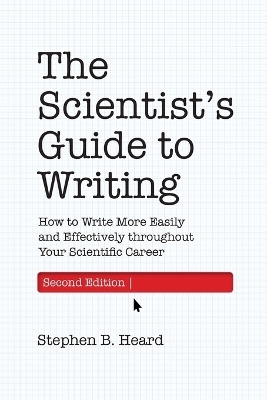
The Scientist’s Guide to Writing, 2nd Edition
How to Write More Easily and Effectively throughout Your Scientific Career
Seiten
2022
|
2nd edition
Princeton University Press (Verlag)
978-0-691-21918-9 (ISBN)
Princeton University Press (Verlag)
978-0-691-21918-9 (ISBN)
An updated and expanded edition of the acclaimed writing guide for scientists
The Scientist’s Guide to Writing explains the essential techniques that students, postdocs, and early-career scientists need to write more clearly, efficiently, and easily. Now fully updated and expanded, this incisive primer offers practical advice on such topics as generating and maintaining writing momentum, structuring a scientific paper, revising a first draft, handling citations, responding to peer reviews, managing coauthorships, and more. The ability to write clearly is critical to any scientific career. The Scientist’s Guide to Writing shows scientists how to become better writers so that their ideas have the greatest possible impact.
New chapters discuss effective reading, choosing the right journal for your research, and the advantages and disadvantages of posting preprints
Provides additional advice on reporting statistical results, dealing with conflicting peer reviews, managing coauthorships, writing with English as an additional language, and more
Emphasizes writing as a process, not just a product
Encourages habits that improve motivation and productivity
Offers detailed guidance on submission, review, revision, and publication
Includes a wealth of new exercises
The Scientist’s Guide to Writing explains the essential techniques that students, postdocs, and early-career scientists need to write more clearly, efficiently, and easily. Now fully updated and expanded, this incisive primer offers practical advice on such topics as generating and maintaining writing momentum, structuring a scientific paper, revising a first draft, handling citations, responding to peer reviews, managing coauthorships, and more. The ability to write clearly is critical to any scientific career. The Scientist’s Guide to Writing shows scientists how to become better writers so that their ideas have the greatest possible impact.
New chapters discuss effective reading, choosing the right journal for your research, and the advantages and disadvantages of posting preprints
Provides additional advice on reporting statistical results, dealing with conflicting peer reviews, managing coauthorships, writing with English as an additional language, and more
Emphasizes writing as a process, not just a product
Encourages habits that improve motivation and productivity
Offers detailed guidance on submission, review, revision, and publication
Includes a wealth of new exercises
Stephen B. Heard is professor of biology at the University of New Brunswick in Canada. He is the author of Charles Darwin’s Barnacle and David Bowie’s Spider: How Scientific Names Celebrate Adventurers, Heroes, and Even a Few Scoundrels. Twitter @StephenBHeard
| Erscheinungsdatum | 08.03.2022 |
|---|---|
| Reihe/Serie | Skills for Scholars |
| Zusatzinfo | 17 b/w illus. |
| Verlagsort | New Jersey |
| Sprache | englisch |
| Maße | 156 x 235 mm |
| Themenwelt | Schulbuch / Wörterbuch ► Wörterbuch / Fremdsprachen |
| Geisteswissenschaften ► Sprach- / Literaturwissenschaft ► Literaturwissenschaft | |
| Geisteswissenschaften ► Sprach- / Literaturwissenschaft ► Sprachwissenschaft | |
| Sozialwissenschaften ► Pädagogik | |
| ISBN-10 | 0-691-21918-4 / 0691219184 |
| ISBN-13 | 978-0-691-21918-9 / 9780691219189 |
| Zustand | Neuware |
| Informationen gemäß Produktsicherheitsverordnung (GPSR) | |
| Haben Sie eine Frage zum Produkt? |
Mehr entdecken
aus dem Bereich
aus dem Bereich
Buch | Softcover (2020)
Beuth (Verlag)
CHF 27,85
Begriffe - Verfahren - Arbeitstechniken
Buch | Softcover (2024)
De Gruyter (Verlag)
CHF 34,90


